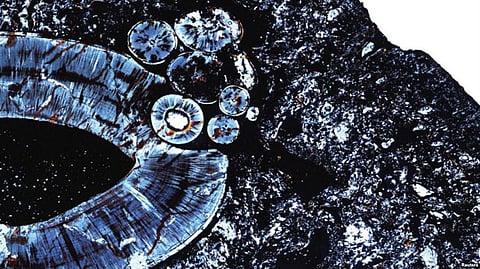
- Home
- न्यूजग्राम
- India
- World
- Politics
- Entertainment
- Culture
- Lifestyle
- Economy
- Sports
- Sp. Coverage
- Misc.
- NewsGram Exclusive
- Jobs / Internships

Washington, December 9, 2016: Scientists examining the jawbone of a saber-toothed, mammal-like beast that prowled Tanzania 255 million years ago have come across a remarkable fossil rarity: one of the oldest-known tumors.
University of Washington researchers on Thursday described a benign tumor composed of miniature toothlike structures they found embedded next to the root of the creature's enlarged canine tooth while studying an unrelated aspect of the jaw.
NewsGram brings to you current foreign news from all over the world.
The animal was a member of an extinct group of four-legged carnivores called gorgonopsians that mixed mammal-like and reptilelike traits. They reached up to 10 feet (3 meters) long and appeared early in the evolutionary lineage that led to mammals. The jawbone came from one of the smaller gorgonopsian species.
Gorgonopsians were among the top predators of their time, thriving from about 270 million to 252 million years ago, when they were wiped out during Earth's worst mass extinction at the end of the Permian Period. Their demise came roughly 20 million years before the first dinosaurs.
When the researchers sliced into the mandible fossil from Tanzania's Ruhuhu Valley, they found a benign dental tumor called a compound odontoma that grows within the gums or other jaw soft tissues. When people get one, surgery is sometimes used to remove it.
NewsGram brings to you top news around the world today.
A handout image of a CT scan of the front half of a lower jawbone of a saber-toothed mammal-like beast that prowled Tanzania 255 million years ago. Bone is shown in red and teeth are in blue. This is not the specimen in which the odontoma was found; it is included as a representative of what gorgonopsian jaws and teeth look like. (Courtesy Christian Sidor/Megan Whitney) VOA
"There was no indication that there was a tumor in this jaw. It looked normal before we cut it open. It was pure luck that we found the tumor," University of Washington paleobiologist Megan Whitney said.
Until now, this type of tumor was known only in mammals, including some Ice Age fossils tens of thousands of years old.
The new discovery shows such a tumor existed in mammal ancestors that lived tens of millions of years before the first mammals appeared.
Tumors, malignant and benign, typically involve soft tissue, and rarely fossilize.
"Ancient tumors generally need to affect hard parts such as bones and teeth in order to be preserved in the fossil record," University of Washington paleobiologist Christian Sidor added.
Check out NewsGram for latest international news updates.
This tumor included hard enamel and dentin.
Few tumor fossils are older. A 300 million-year-old fish was found with a tumor, and a 350 million-year-old armored fish was found with an apparent tumor.
"Fossils allow us to understand the evolution of diseases in deep time and have the potential to provide clues as to the causes of diseases that afflict humans," Whitney said.
The research appears in the Journal of the American Medical Association Oncology. (VOA)
